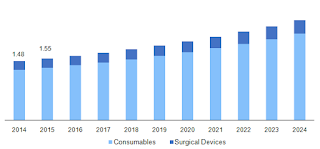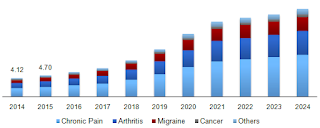The Molecular Diagnostics Market was valued at over USD 6.40 billion in 2015.
It is likely to grow at a CAGR of around 9% during the forecast period
(2016-2024).
Increasing
prevalence of infectious diseases, cancer, genetic disorders, and other
contagious disease are likely to drive the molecular diagnostics industry.
Hospital acquired infections and other communicable infections are expected to
boost market growth in the coming eight years. Moreover prenatal genetic
testing is also expected to increase the adoption of this diagnostics.
Unhealthy lifestyle
can further contribute to large number of people getting afflicted with chronic
ailments like cardiovascular disorders and diabetes. This with further propel
market growth in the coming years. Molecular diagnostics market is divided into
products, technologies, applications, test location, and regions.
On the basis of
products, the market is split into instruments, reagents, and others. Reagents
segment held the largest share in 2015 with revenues exceeding USD 3.5 billion.
It is expected to grow at a CAGR surpasing 12%. Instruments segment is expected
to show a significant growth in the coming years.
Browse Details of Report @ https://www.hexaresearch.com/research-report/molecular-diagnostics-industry
Technologies
consist of polymerase chain reaction (PCR), in-situ hybridization, chips and
microarrays, mass spectrometery, DNA sequencing, transportation mediated
amplification, and others. PCR held the largest market share of over USD 2.5
billion in 2015. Growth of this segment can be attributed to its high
incorporation among the researchers and healthcare professionals. DNA
sequencing is likely to show a growth of about 16% CAGR in the coming years.
Applications
encompass oncology, pharmacogenomics, infectious diseases, genetic testing,
neurological diseases, cardiovascular diseases, and others. Infectious diseases
segment was the largest application holding market share exceeding 45% in 2015.
Oncology segment is
anticipated to show a CAGR of about 13% till 2024. Rising awareness among
people regarding early cancer diagnosis is the key aspect propelling market
growth of the segment.
Test location
comprises of point of care (PoC), self test or over the counter (OTC), and
central laboratories. Central laboratories dominated the market with over 60%
shares in 2015. The growth of the central laboratories can be attributed to
their large prominence in underdeveloped countries, rising awareness about
early detection of diseases, and high procedure volumes.
The PoC is expected
to project a lucrative growth with a CAGR of more than 14%. The growth of this
segment can be attributed to the increasing demand of bedside patient
monitoring and innovative technological devices.
Regions are
fragmented into North America, Latin America, Europe, Asia Pacific, and the
Middle East & Africa (MEA). America dominated the market with over 40%
revenue share. Asia Pacific is likely to exhibit a growth of around 12%CAGR in
the coming years.
The key global
players of the molecular diagnostics market include Siemens Healthcare GmbH,
Novartis AG (Grifols), F. Hoffmann-La Roche Limited, and Johnson & Johnson.
About Us:
Hexa Research is a
market research and consulting organization, offering industry reports, custom
research and consulting services to a host of key industries across the globe.
We offer comprehensive business intelligence in the form of industry reports
which help our clients obtain clarity about their business environment and
enable them to undertake strategic growth initiatives.
Contact Us:
Ryan Shaw
Hexa Research
Felton Office Plaza
6265 Highway 9
Felton, California
95018
United States
Phone:
+1-800-489-3075
Email: sales@hexaresearch.com
Website -
http://www.hexaresearch.com/





